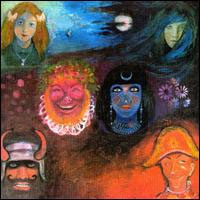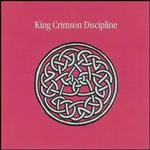Features
DeConstruKction
King Crimson Albums Ranked Worst to Best
by Benjamin Ray
13. The ConstruKction Of Light (2000)
After the double trio format that produced the superb THRAK split up, the remaining quartet forming King Crimson went on to do separate things in different incarnations, dubbed ProjeKcts. During the late ‘90s, a lot of live releases of these different projects were released, and in the middle of it all the quartet came back together for a new studio album in 2000 using the spirit of these ideas. The problem is, like free-form jazz, the ideas just weren't that great, and the resulting album is meandering, mostly dull and free of the tension, fracture, and innovation that infuses the band's other albums.
 12. Lizard (1970)
12. Lizard (1970)
All art-rock bands need to have their one sidelong epic (Yes, ever the practitioners of restraint, had six in four years), and Crimson's was the title track from their third album. The problem is that the song starts off as prime British prog-rock, with Yes' Jon Anderson singing vocals, but then devolves into jamming, noodling, and very little to keep the listener interested. The first side wasn't much better, with several embarrassing songs that nobody sounds too invested in and that Robert Fripp seems to want to forget, based on compilations and live shows. Only “Cirkus” offers something worthwhile with its warning-siren chorus.
11. Beat (1982)
Following Discipline would have been impossible, and Beat is not up to the task. More New Wave-inspired than its predecessor, and about 1% more pop-oriented than any previous Crimson album, the songs here are fairly pedestrian, lacking the catchiness or innovation required to push them to the next level. That said, the unusual, polyrhythmic playing, myriad guitar tones and overall feeling of exploration is uniquely Crimson and keeping in tune with the album's theme of the Beat generation. Opener “Neal And Jack And Me” is a solid Adrian Belew alt-pop tune, “Heartbeat” is the closest the band got to a straight pop song, “Sartori In Tangier” is a fine instrumental, and “Waiting Man” features some world music influence. The other half suffers in comparison, and the overall effect results in an album not likely to get many spins.
 10. Three Of A Perfect Pair (1984)
10. Three Of A Perfect Pair (1984)
The third and final album of the band's ‘80s output, this one is a touch better than Beat thanks to the presence of the title track, the paranoid slap-bass-heavy “Sleepless,” and the lovely, haunting “Nuages (That Which Passes, Passes Like Clouds).” Two awful pop songs clog up the rest of the first side and the second side is given over to the usual Crimson instrumental jams, albeit with less structure and more clanking atmospherics; only “Larks' Tongues In Aspic, Pt. III” achieves any sort of momentum, but it seems a lazy attempt to invoke a great album of old just to tie the band name to it. Still, while four songs of nine is hardly a great album, they are worth finding for those exploring the band.
9. Starless And Bible Black (1974)
Sandwiched between two superb albums, Starless is more difficult than either of those, easy to admire for its truly progressive nature but hard to love. Things start out with some actual songs, albeit the avant-garde British kind that only the dedicated love (“The Great Deceiver,” “Lament,” and “The Night Watch”). Much of the rest of the music is instrumental, taken either from on-stage snippets (the pointless “We'll Let You Know”) or actual compositions that challenge the listener (the title track and “Fracture”). It's not an easy album by any means, but it has virtues for the patient, and King Crimson fans are by nature patient.
 8. The Power To Believe (2003)
8. The Power To Believe (2003)
As this will evidently be Crimson's final album, it's not a bad way to end their recorded history, unless the 2014 triple-drum version of the band gets into the studio (fun fact: the lead singer now is a guy named Jakko). Shedding the indulgences of the ProjeKcts, the quartet used their entire history plus a newfound love of electronics to record this disc, to fine results. “Dangerous Curves” is classic Crimson, a long, slow buildup with exciting, spooky passages that leads to a noisy denouement, while “Happy With What You Have To Be Happy With” skewers the modern rock on the radio at the time, proving that King Crimson, at last, found it sense of humor. The four parts of the title track give the album continuity and identity, while “Level Five” and “Eyes Wide Open” are thoroughly modern tracks from a band that started in 1969 as a true original.
7. In The Wake Of Poseidon (1970)
Because the debut worked so well, Crimson decided to replicate most of it for the follow-up, losing Greg Lake in the process to a new outfit called Emerson, Lake & Palmer. Poseidon is nowhere near as good as its predecessor, but it's still a fine slice of British prog-rock circa 1970, if you like Mellotrons and stupid lyrics and eight-minute songs about Greek mythology or cat food or urban decay. The clanking, horn-heavy, industrial “Pictures Of A City” is bracing and in-your-face, a stark contrast to the lovely acoustic “Cadence And Cascade,” the goofy but sorta catchy “Cat Food,” and the long, slow, keyboard-slathered instrumental “The Devil's Triangle,” the first in a Crimson tradition of long buildups to noisy fadeouts. The title track is akin to the title track from the debut, all Mellotron and mood, but Lake's singing in the final words of each verse is chilling as he reaches up to the high notes.
 6. Islands (1971)
6. Islands (1971)
This album is unfairly slagged by critics and deserves more love. The ever-rotating collective of band members now featured Boz Burrell singing and bassing (he would go on to Bad Company after this disc) instead of Greg Lake or Gordon Haskell, and it was clear the original idea that spawned King Crimson was starting to run dry after the abysmal Lizard. But Islands features several great passages in its six songs, notably the up-and-down bass runs of the frenetic “Sailor's Tale,” the absolutely lovely “Prelude: Song Of The Gulls,” the peaceful, stately title track that slowly builds in intensity before ending on a final mournful note, and the vocal harmonies (a big surprise) on the otherwise-decadent “Ladies Of The Road.” It's far from perfect, but it's better than you have been told.
5. Red (1974)
The only album released as a power trio, Red featured the lineup of Fripp, Bruford and Wetton and intermittent saxophone, cornet and oboe. Unlike the last two albums, Red is remarkably clear-headed and bullshit-free (save for the interminable wankery of “Providence”), and offers the powerful instrumental “Red” and the soaring, moving “Starless,” two of the band's best songs from this era. “One More Red Nightmare” is a solid prog-rocker and “Fallen Angel” is a lesser but still decent tune in the same vein. The band fell apart after this for seven years, leaving Red as the last will and testament to a fascinating era of the band and one of Crimson's best albums.
 4. Larks' Tongues In Aspic (1973)
4. Larks' Tongues In Aspic (1973)
Fripp knew a change was needed after Islands, and he rounded up a new band, including a violin player, Bill Bruford from Yes and an unknown singer/bassist named John Wetton, who would later go on to star in Asia. The resulting music is less jazz-oriented than before, pushing the limits of what progressive rock was (more than most, Crimson truly embodied the progressive term) and daring to experiment with song structures, sounds and atonal dissonance. “Book Of Saturday” and “Exiles” are the most “normal” songs here, and both are solid, and part one of the title track is a wild, weaving, difficult piece of music that demands patience and generally rewards it. However, it is the final two songs that warrant repeated listens. “The Talking Drum” is the most effective use of Crimson's patented slow buildup to strong release pattern – which in this case is shrieking – before part two of the title track comes in, all monster electro-power chords that alternate with slower violin-led passages. You have to be in the right mood for this one, but it's worth it.
3. In The Court Of The Crimson King (1969)
The debut still ranks as a beloved prog-rock touchstone, and there really wasn't anything like it at the time. The proto-metal “21st Century Schizoid Man” announced the band in a major way, but the epic “Epitaph” is the true standout of the debut, with Greg Lake's vocals and Fripp's Mellotron interlocking in spooky, majestic ways. “I Talk To The Wind” and “Moonchild” are the more precious, twee halves of the other songs, while the title track bridges both approaches. With the cover art, the lyrics, the overwhelming sound and the lack of concession to anything commercial, King Crimson and this album immediately stood out from the pack, and in a year where experimentation ruled, KC instantly developed a cult following.
 2. Thrak (1995)
2. Thrak (1995)
After taking a decade off, Crimson added two members and formed a “double trio,” an experiment of two bands of three working apart and together, often in the same song. But rather than use this to write 12-minute free-form jazz noodlings or self-important inaccessible math rock, the band used its hard rock and pop leanings to create a truly great modern prog album. The skewed, avant-garde lines of Talking Heads are probably the closest comparison, but the guitar crunch of “Dinosaur” is Crimson moving into the ’90s, as is the mind-warping, spooky midsection of the song. “People” plays it somewhat straight until an extended instrumental fadeout, “B’boom” makes the most of its two drummers with an onslaught and both the title track, “VROOOM” and “Coda: Marine 475” revisit the heady instrumental days of “Red” to superb results. “Walking On Air” is hands down the best ballad the band ever recorded, Belew reaching into his upper register to deliver a more moving song that Fripp had ever intended for this band, the jagged “Sex Sleep Eat Drink Dream” is true avant noise-pop that only Belew could have pulled off at this point, and “One Time” is a moving, world-beat-inspired ballad with an absolutely gorgeous midsection that sounds like sadness personified. With a mix of true emotion, hard rock crunch, unconventional but accessible songwriting and signature Crimson flairs and approaches, this is one of the band’s finest hours, and it’s a shame they abandoned this approach so quickly in favor of the ProjeKcts that would take up the rest of the decade.
1. Discipline (1981)